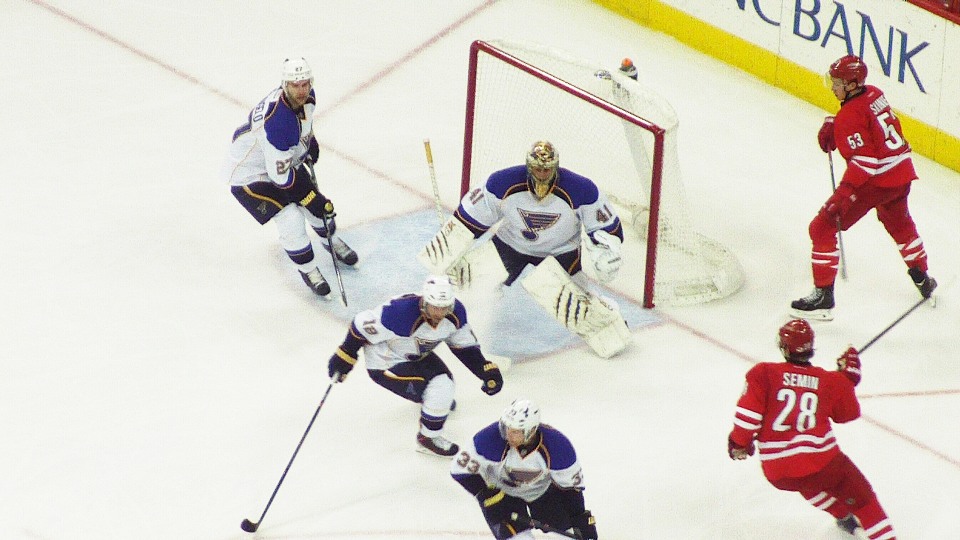
RALEIGH, N.C. – When the Carolina Hurricanes face off against the St. Louis Blues at PNC Arena on Friday, there will probably not be too much of a change, in any, in the lineup for the home side.
Riding a current 7-2-1 performance in the month of January that includes a three-game win streak, extended by a 4-2 win over the Tampa Bay Lightning on Tuesday, Carolina head coach Bill Peters is keeping it simple.
If it ain’t broke, don’t fix it as the saying goes.
It’s expected that the Hurricanes will once again start Anton Khudobin in net, winner of six games in as many starts, while Alexander Semin, Andrej Nestrasil, and John-Michael Liles will likely sit and watch from press row again.
That’s how it’s gone for Carolina recently, and has raised much attention considering that Semin, the seven million dollar man, has been a healthy scratch over that time and for other stretches of games this season peppered with stints of sitting out with injury.
It’s a situation that now has been validated by a decision from the Los Angeles Kings to waive two-time Stanley Cup winner Mike Richards, a 5.75 million dollar player, who is expected to start in his first-ever American Hockey League (AHL) game on Friday.
This is not an analysis of the reason(s) why Semin or Richards are both currently in the NHL version of pro hockey purgatory.
No, this is more of thought piece on the mess that NHL owners and players have placed themselves as of two years ago when they renegotiated what eventually became the current National Hockey League (NHL) Collective Bargaining Agreement (CBA).
A broad glance from a layperson’s view shows that its major flaw has now been exposed.
Before the league’s lockout of the players took place, many teams, including Carolina, staked their long-term claim to the players they valued most, a top-five, six, or seven, by signing them to inflated, long-term contracts.
As the eventual CBA was agreed upon, it looked like each side got pieces of what they needed.
For the players, a higher average salary, more related quality-of-life areas addressed, along with a decent revenue sharing commitment, seemed reasonable to agree to without starving much longer past January 2013.
For the owners, a salary cap that their general managers would have to work with and control according to how the league’s finances and economy fluctuated, once again provided them the upper hand.
However, all of this came with a glitch.
With the new CBA in place, the league’s GM’s could go to work knowing that every team was committed to and in some cases, stuck with, inflated contracts with potential poor ROI possibilities.
They never believed it would happen, but never say never.
The skill players had gotten their pay days, committing to higher dollar, long-term contracts.
Call it long-term security.
However, with all that in place, the rest of the league’s players have had to scramble to earn a spot on an NHL roster at lower market values and with short-term contracts that weren’t guaranteed one-way deals.
The big contracts removed the league’s middle class, so to speak.
It was talked about, and now they are all living in the reality of it.
Many who were in the league three years ago, are no longer.
There’s not enough room for them.
If you think the trend to find high-performing ‘glue’ guys and a strong bottom six wasn’t an immediate outcome from the CBA, you are mistaken.
GM’s and subsequently coaches now have no choice but to work with what they’ve got and find those types of players.
The challenge is that low-paid players don’t mysteriously turn into high-end talent.
There’s a reason they have been at the lower-end of the salary scale.
So assuming your highly paid and apparently and hopefully high-performing stars are doing their job, and if a smart hockey exec has been able to shine some muddied gems they’ve pick up as free agents or low-level trades, success has resulted.
Or not.
The problem arises when your top-paid and played players are suddenly not performing and executing to expectations.
All efforts are exhausted to match the player up with different line mates, changing their position on the ice, and on the roster.
However, if all of that doesn’t work, eventually it has to come to a head that a GM has to decide to actually go there – sit or even waive that player.
Case in point are Semin and Richards.
So, in the face of it all, who’s really won in this situation, the owners or the players?
Two top-level players, under-performing for whatever reason, are no good to their teams while eating up salary money that could be spread around to two or three others who would die for a spot to prove they can get the job done.
On the other hand, teams have boxed themselves into a situation that has fans clamoring to make changes to their roster due to poor performance, but are unable to do so due to poor contract signings which are exacerbated by no-trade clauses to boot.
Is this a short-term glitch or a long-term dilemma for the NHL?
That won’t be known until the Semin and Richards case studies play out.
